animal cell culture
...
outline
- characteristics of animal cell culture
- growth factors
- cell cycle
- cell transformation and elements of cancer
1. CHARACTERISTICS OF ANIMAL CELL CULTURE
...
...
- animal cells cannot live outside their in vivo tissues / environments
- a cell culture is the maintenance of the cells in vitro (on glass)
- cell culture involved taking cells from their natural setting, characterizing their growth and functional properties, and keeping them in culture so that they are readily available for experimentation
Start w/ animal cell culture
- if were unable to culture, wouldn’t be able to study viruses (extraction from ppl not practical)
- animal cells cannot live outside of their natural (in vivo) environment
- culturing is taking cells from vivo environment to conditions in another place they can grow (in vitro)
cells can be grown in culture
cells grown in culture provide more homogenous population of cells from which to extract material, and they are also much more convenient to work with in the lab
in sterile plasticware
ex vivo cell culture
extracting the cells from animals/humans
(extracting primary cells from them)
in vitro
In vitro literally translates from Latin as “in glass.” These methods involve experimenting with cells outside a living organism. The original reference to glass is quite literal since in vitro experiments were historically conducted in Petri dishes or test tubes, made of glass. In vitro cultured cells are purified and isolated from their natural biological environment.
(google)
ex vivo
Ex vivo literally translates from Latin as “out of the living.” In these experiments, living tissues are directly taken from a living organism and immediately studied in a laboratory setting with minimal alterations to the organism’s natural conditions. An example of this is the use of human skin explants derived from surgical procedures.
in vivo
these investigations refer to experiments in live animals (NOT in cell cultures)
when conducted in humans = clinical (translational) research
studying animal as a whole
isolating cells and growing them in culture
isolated from INTACT TISSUE where they live in body
- disrupt ECM and cell-cell junctions that hold cells
together
- treat w/ proteolytic enzymes (trypsin, collagenase) = digest + destroy proteins in ECM
- treat w/ agents as EDTA that bind Calcium ions that cell-cell adhesion depends on
- tissue can be separated into single cells by agitation
cells can be separated from a mixed cell suspension
- most general cell separation techniques: use antibodies coupled to flourescent dyes/magnetic beads = label specific cells (cell sorting)
- antibody - molecule produced by B lymphocyte, specifically recognizes certain structures of other molecules (antigens)
primary cell cultures
- cell cultures established from organs/tissues
- eventually die
- most cells stop dividing after 50-70 divisions in culture
- experience senescence and death
- this limit of division = hayflick limit
hayflick limit
replication capacity of a cell before experiencing senescence and death
only occurs in differentiated cells (stem cells can continue to divide)
this occurs in our bodies as well
senescence due to
progressive shortening of telomeres
telomeres
repetitive DENA caps of end of each chromosome
telomerase
elongates telomeres, which are shortened after each cell division
cells stop making telomerase, which is why their telomeres shorten with each division -> leading to eventual senescence and death of the cell
cancer cells express telomerase continuously
since express it, their telomeres do not shorten, and thus, cancer cells are immortal
fate of primary cells
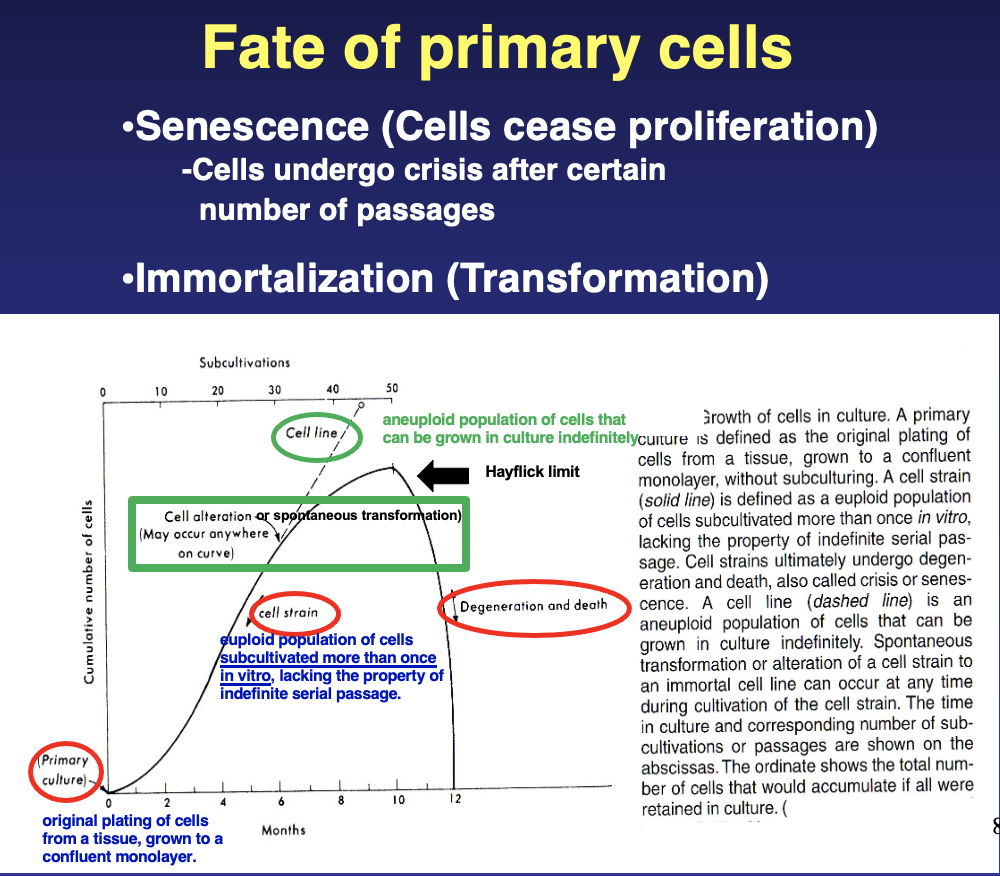
senescence
- cells stop proliferation after certain number of divisions (hayflick limit)
- if stay normal cells
- cell strain - euploid population of cells subcultivated in vitro more than 1 time. euploid (normal number of chromosomes)
- before senescence is reached, cell may be changed by viruses, carcinogens, etc or spontaneous transformation -> into a cell line (immortalization)
immortalization
- cell line - aneuploid population of cells that can be grown in culture indefinitely
- aneuploid - abnormal number of chromosomes or changed chromosomes. They have been lost/acquired or have been changed.
- if primary cells (normal cells) undergo transformation into abnormal cells
- cell line can be cultured indefinitely due to telomerase continuation
cell lines
- able to divide indefinitely in culture and do not die (continuous cell growth)
- they do express telomerase activity
- what cancer cells do
transformed cell line
- line of cells derived from the cell lines
- in vitro characteristics of tumor cells (foci)
- can turn into these bc of carcinogens, transforming viruses, etc
tumor cell lines
cell line derived from primary tumor cells (ex vivo tumor cells, from an organism)
transformed cell lines and tumor cell lines grow...
without attaching to a surface and proliferate to much higher density in a culture dish
normal cells treated with carcinogenic chemical compounds or with transforming viruses can result in...
these injected in mice can cause
transformed cell line
can cause tumors in mice
if injected into mice and cause tumors, the chemical is considered
carcinogenic
short and long term test for genotoxicity and carcinogenicity (transformation test)
all cell lines kept frozen in liquid nitrogen + retain viability when thawed
...
cell lines differ in important ways from normal progenitors in tissues from which they were derived
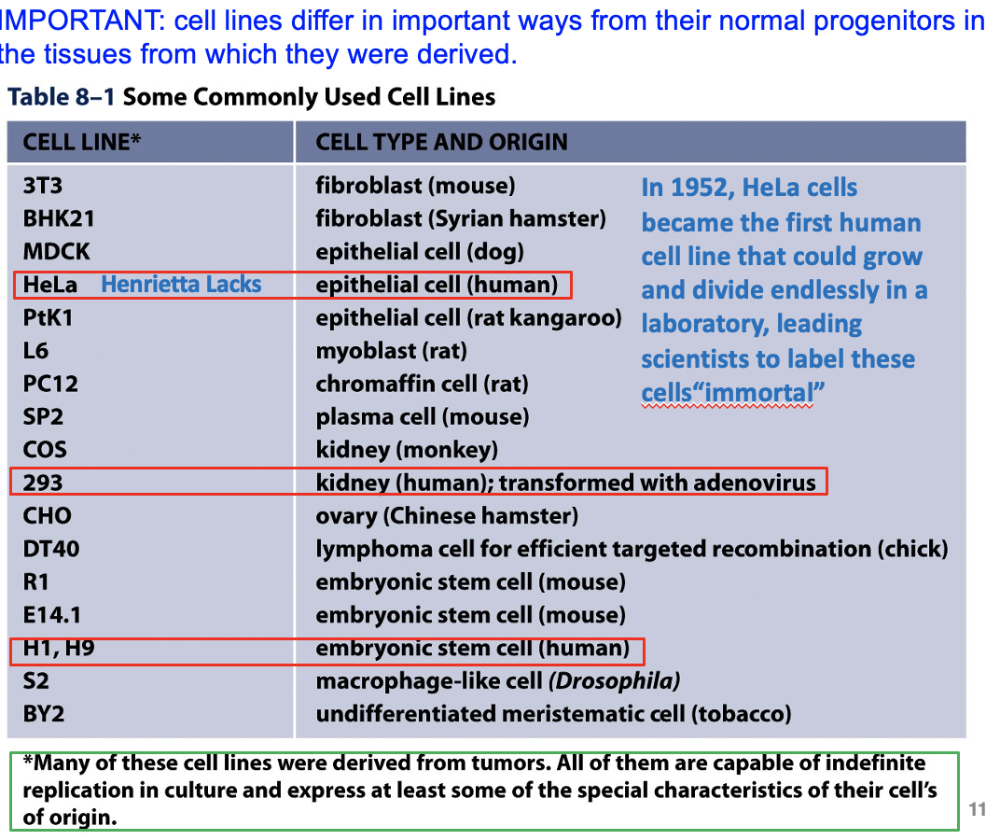
see slide, dont fully understand
cell culture medium
- must resemble blood plasma, so has things to make it as similar
as possible
- amino acids
- vitamins
- glucose
- buffers (sodium bicarbonate)
- serum (FBS, fetal bovine serum)
- antibiotics
- other additives depending on cell type
types of cells in cell culture
all animal cells in culture are derived from living animal tissue
adherent vs suspension
- adherent - if comes from solid tissue
cell types
- primary cells
- eventually stops replicating
- continuous cell
lines
- includes transformed/tumor/spontaneous altered cells
- stem cells
- exist so organs can repair themselves
stem cell line
group of stem cells (self renewing cells) that is cultued in vitro and can be propagated indefinitely
derived from either animal or human tissues and come from 1 of 3 sources:
- embryonic stem cells
- adult stem cells
- induced stem cells
properties of primary cells
- normal chromosome numbers (euploid) and shape
- require high serum concentration
- finite lifespan (30-50 cell passages)
- display properties of differentiated cells
-
respond to modulators of cell growth
- respond to growth factors, inhibitors, etc
- if introduced back into an animal they were isolated from, they may survive, but do NOT produce tumors
- adherent cells (like epithelial cells and fibroblasts) need contact with solid surfaces for division (anchorage dependent growth)
- subject to contact inhibition (stop growing when touch neighbor cell, grow again when have space)
properties of continuous cells (cell lines)
- fragmented and reduplicated chromosomes (aneuploid) (abnormal)
- may have anchorage independent
growth
- dont need to be anchored to duplicate
- require only low concentrations of serum
-
immortal - divide forever
- bc of telomerase
- do not respond to neighboring cells (no contact inhibition)
- do not display properties of differentiated cells
- do not respond to modulators of cell growth
effect of virus infection on cells
exert modifications on cells
-
cytopathic (cytolytic) viruses
- kill their host cells (lysis)
- either completely eliminated by immune system or kill infected organism (lysis)
-
noncytopathic viruses (LCMV)
- propagate without killing their host cells
- leave cell via other mechanisms
-
persistent virus
- ex: herpes virus, chickenpox, shingles
- lytic/latent life cycle
- CANNOT be cured of this virus
- virus hides until immunosuppression, then comes out
- cytopathic or cytopathogenic effects (changes in host cell
caused by viral invasion)
- change morphology
- apoptosis
- necrosis
- cell fusion (syncytia)
- hemagglutination
- change in growth or lifespan
- oncogenic transformation
change of cell morphology after viral infection
herpes simplex virus (HSV)-induced changes in properties of actin microfilaments of cultured monkey fibroblasts
necrosis vs apoptosis
apoptosis - active, programmed process of autonomous cellular dismantling occurring in a cell, that avoids eliciting inflammation
necrosis - passive, accidental cell death of a group of cells resulting from environmental pertubations with uncontrolled release of inflammatory cellular contents
some viruses use necrosis, some use apoptosis
cell fusion (syncytium)
viral proteins that mediates fusion of an infected cell with neighboring cells leading to the formation of multi-nucleate cells called syncytia
Virus with this put molecules on surface that cause fusion of cell with neighboring cell
- flu does this, COVID, and syncytium respiratory virus
hemagglutination
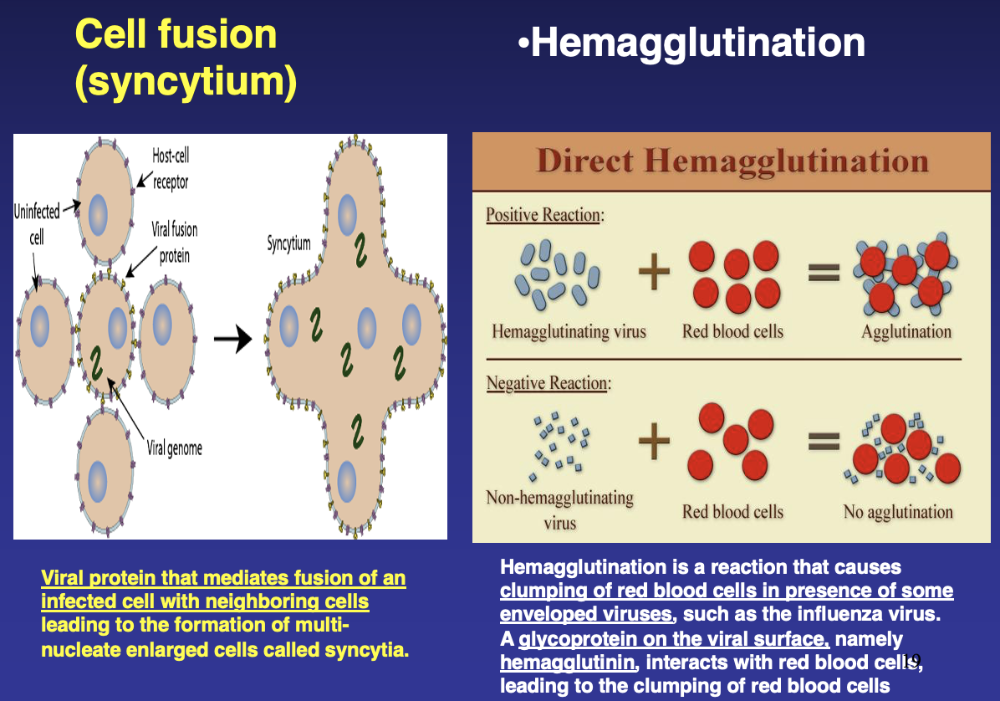
rxn that causes clumping or RBC in presence of some enveloped virus, such as the influenza virus
glycoprotein on viral surface (hemagglutinin) interacts with RBCs leading to clumping of RBCs
Hemagglutination
- flu virus does this
- virus attach to RBC and agglutinate / clump RBC
oncogenic transformation by rous sarcoma virus (RSV)
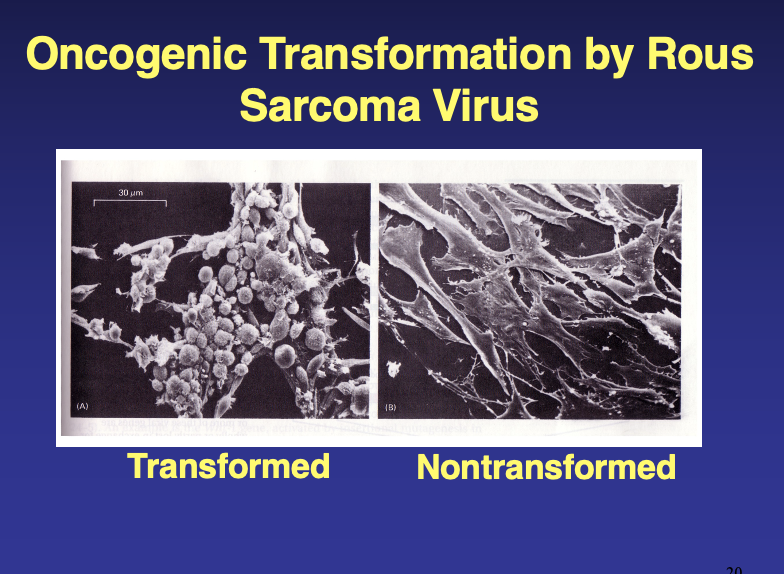
transforming virus
make tumors
primary cells / cell lines / immortality/ telomers / telomerase: summary
which are cells that can replicate?
-
in vivo - in embryo and adults
-
embryo - embryonal cells, stem cells
- pluripotent - undifferentiated, can become any cell type
-
adult - adult stem cells
- multipotent - restricted to become any type of cell in the tissue/organ they reside (bone marrow, fat, brain, blood vessels, skin, teeth, heart, liver)
- adult stem cells replace cells lost in tissue as needed (ex: skin growth every day)
-
benign + malignant (cancer) tumor cells
- telomerase expressed/activate in tightly controlled + regulated fashion, except in malignant cells where it is cont. expressed/activated and they are then immortal
-
embryo - embryonal cells, stem cells
Embryo stem cells - Pluripotent – undifferentiated, can become any type of cell
Adult stem cells – multipotent
- replace cells lost in tissue/organ they reside as needed
Benign and malignant tumor cells
- tumor cells can be benign – have capacity to replicate, but do not metastasize and invade
- telomerase expressed regulated/controlled
which are cells that can replicate?
now in vitro:
- primary cells - limited capacity: hayflick limit, telomers shorten progressively, senescence, death
- telomerase continuously expressed/activated enabling cell
immortality in the following:
- spontaneous generated cell lines
- transformed cell lines
- tumor (cancer) cell lines
telomerase - (an enzyme) is a ribonucleoprotein complex
- catalytic core: telomerase reverse transcriptase (TERT)
- noncoding human telomerase RNA (hTR) which serves as template for the addition of telomeric repeats to chromosome ends
cellular senescence is a permanent proliferation arrest that occurs in response to:
endogenous and exogenous stresses, including telomere dysfunction
also to oncogene activation, tumor suppressor genes inactivation, oxidative stress, mitochondrial dysfunction, and persistent DNA damage
senescence occurs at the ___ levels and is related to the ___ process but not necessarily ro death
- cellular, tissue, organ, and body levels
- related to the aging process
senescent cells start producing what molecules?
inflammatory
II. GROWTH FACTORS
part 2 of lecture
- secreted proteins which exert their effects at very low concentrations (1-^-9 to 10^-11 M)
- regulate protein synthesis and cell growth
- act on cells that express specific receptors
- can stimulate or inhibit proliferation or differentiation
- over 60 known growth factors
- broad specificity
- narrow specificity
growth factors = proteins
growth factors and their actions
the main growth factors
dont need to memorize
produced by diff cell types
macrophages make most types of growth factors
growth factor signaling pathways
kinases - enzymes that phosphorylate (add phosphate groups)
growth factor -> receptor -> 1st and second activated kinases -> in nucleus, activated gene regulatory proteins -> early response genes -> delayed response genes = activated cell cycle control system
= typical signaling pathway for stimulation of cell proliferation by a growth factor
growth factors act on specific receptors
- end: give info in nucleus for cell to express certain thing
interact w/ receptor -> phosphorylate -> kinases activated / phosphorylated
-> kinases go to nucleus -> activate gene/regulatory proteins
-> genes have to do w/ expression, regulation, etc
4 types chemical signaling
- autocrine
- cell targets itself
- signaling acts on the signaling cell
- 1 cell produce growth factor that goes back to interact w/ growth factor on same cell that produced it
- Bc only way to induce this function, must go out and activate the cell signaling pathway
- signaling across gap junctions
- cell targets a cell connected by gap junctions
- signaling molecules moving directly between adjacent cells
- internal receptors found in cell cytoplasm
- bind ligand molecules that cross the plasma membrane
- paracrine
- a cell targets a nearby cell
- signaling act on nearby cells
- Growth factor act on receptor in neighbor cell
- endocrine
- a cell targets a distant cell through the bloodstream
- signaling uses the circulatory system transport ligands
III. the cell cycle
part 3
- the cell cycle, or cell division cycle, is the series of events that take place in a cell leading to its division and duplication (replication)
- cell cycle can be divided in 2 periods
- interphase
- cell growth
- mitosis
- cell division into 2 daughter cells
- cell cycle consists of four distinct phases
- interphase
- G1 phase
- S phase
- G2 phase
- 4. M (mitosis)
cell cycle checkpoint
- checkpoints used by cell to monitor + regulate progress of the cell cycle
- checkpoints
- G1 - ensure ready for DNA synthesis
- G2 checkpoint - ensure ready to enter M phase and divide
- if not, mitosis avoided
- metaphase checkpoint - ensure cell ready to complete cell division
- chromosomes aligned?
cells can enter nongrowing G0 state
- serum deprivation of proliferating cells in culutre leads to growth arrest and entry into a specialized, nongrowing state og G0
- rate of protein synthesis is dramatically reduced in G0 (20% compared to proliferating cells)
- cells in G0 cannot progress past the G1 checkpoint
After exit mitosis, cells may be deprived of serum -> growth arrest
= cannot go into G1 ( stay In G0 - nongrowing state)
cell cycle synchronization
- cell cycle synchronization is a procces by which cells in a culture at diff stages of the cell cycle are brought to the same phase
- cell synchrony is a vital process in the study of cells progressing through the cell cycle as it allows population-wide data to be collected rather than relying solely on single cell experiments
- the types of synchronization are broadly categorized into 2 groups:
- physical fractionization
- chemical blockade
In cell culture, all cells at diff phases in cell cycle at one specific time
If need all cells to be in the same stage at the same time, allows population-wide data to be collected
- can do this by:
1.Serum starvation
2.chemically
- nocodazole-arrests cells at metaphase stage
- hydroxyurea - blocks cells in S phase
- mimosine - late G1 arrest
IV. CELL TRANSFORMATION AND ELEMENTS OF CANCER
part 4
Generation of transformed cells (mechanisms of cell transformation)
- culturing of primary cells for long periods (rodent cells)
- mutagenesis (genotoxic chemical compounds or other means)
- mutagens can transform the cells
- tumor viruses (HTLV-1)
- viruses can transform the cells
- transfection with oncogenes
- oncogenes can be responsible for inducing cancer
- can be isolated from tumors (= tumor cells)
malignant cell transformation refers to the "initiation" first step on carcinogenesis model
(???????????)
- as occurring in any cell w/ initiating first mutation in any gene relevant to cancer
- malignant cell transformation can be achieved by tumor viruses, chemical carcinogens, etc.
- initiation - initiated cell
-> cell proliferation
-> promotion (altered cell foci prenoplastic lesion)
-> genomic instability and increased cell proliferation (addl
genotoxic and promoting carcinogens)
-> progression (invasion
and metastasis) = cancer
= carcinogenesis somatic mutation theory model
Model of cancer genesis
Malignant transformation – initiation – when cell turns cancer
Cancer progress through years from 1st cell’s initiation
Initiated cell can be repaired by DNA repair mechanism
- if DNA mutation remains, then another body system finds the cell and eliminates it
- if still have tumor cell, then these two systems failed to eliminate it
- then cell will proliferate -> become tumor
- progression – when benign tumor has a cell that then invades blood vessel and metastasizes
qualities of transformed cells
- immortalization
- aberrant growth control
- loss of contact inhibition
- anchorage independence (colony formation in soft agar)
- tumorigenicity (tumor formation in animals)
- malignancy (formation of an invasive tumor in vivo)
note: transformation is a multistep process, and varying degrees of transformation are measurable
molecular determinants in the conversion from normal to the malignant cellular phenotype: "hallmarks of cancer"
- growth signals
- self-sufficiency in growth signals
- dont need info from growth factors
- insensitivity to anti-growth signals
- cell division
- limitless potential for cellular replication
- escape from apoptosis
- oncogenesis
- tissue invasion and metastasis
cancer cannot be described in vitro, but only in vivo (invasion and metastasis)
Diagnosis in cancer can ONLY be done by a biopsy – shows invasion + metastasis
- invasion when a cell of the benign tumor breaks the yellow membrane and goes into extracellular matrix and into blood
2 classes of genes in cancer
oncogenes and tumor suppressor genes
proto-oncogenes
- normal genes in a genome
-
proto-oncogenes - normal genes that stimulate
cells grow and divide
- ex: growth factors, mitogens, receptor tyrosine kinases, serine-threonine kinases, GTPases, transcription factors, etc.
- an "activated"
protooncogene is called an oncogene
- causes cancer thru gain of function
- one of main characteristics of cancer is uncontrolled ell growth
- can
become activated by a variety of genetic mechanisms
- including transduction, insertional mutagenesis, amplification, point mutations, chromosomal translocations
- examples of protooncogenes
activated to oncogenes:
- Ras
- HER2
- Myc
- Cyclin D
activated proto-oncogenes
- an oncogene that gained function via diff things (amplification, mutation, etc.)
more abt proto-oncogenes
- important regulators of biologic processes
- despite their name, do NOT reside in genome for purpose of promoting neoplastic phenotype (tumors)
- they are essential to normal biologic processes
- play diverse roles in control of
cellular growth
- ex: proliferation, apoptosis, genome stability, differentiation
- a gene that causes the transformation of normal cells into tumor cells
oncogenes associated w/ retroviruses
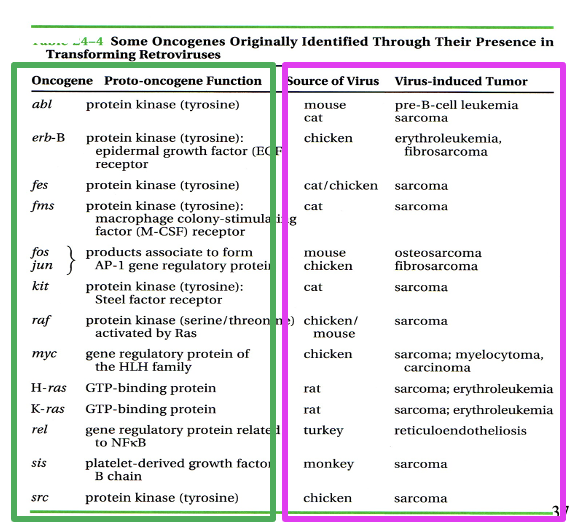
cellular oncogenes and their functions
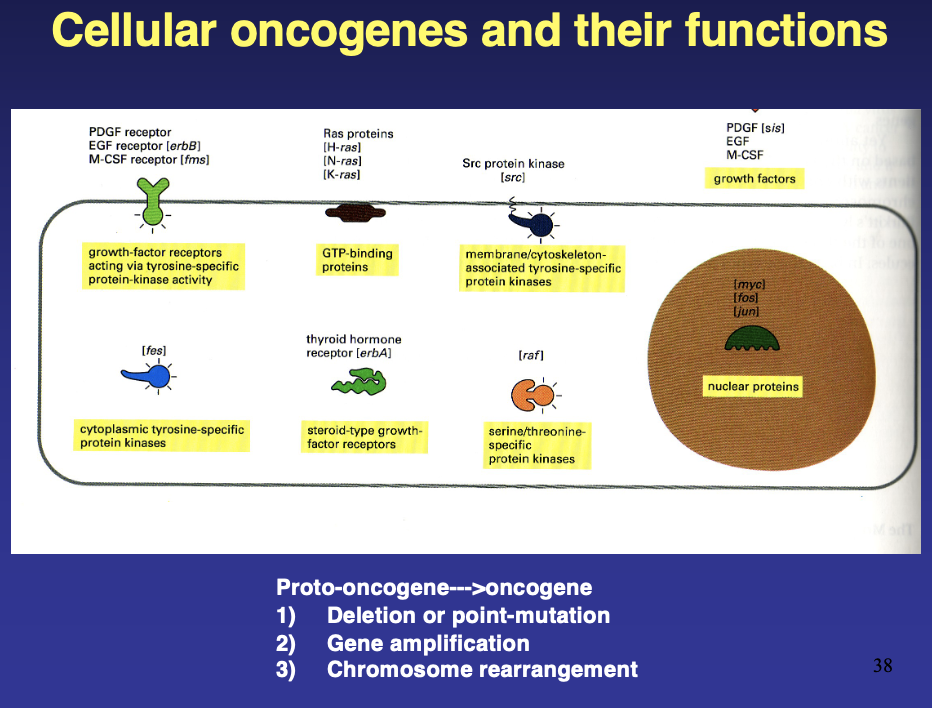
diff functions of growth factors
- all are protooncogenic functions required by normal healthy cell to function
- if any are activated, then have an oncogene
- ex: growth factor receptors acting via tyrosine-specific protein-kinase activity
tumor suppressor gene s
- provide negative control of cell proliferation in normal genes
- loss of function of proteins encoded by these genes liberates the cell from growth constraints and contributes to malignant control
- these are BRAKES in proliferation of cells
- both
copies of tumor suppressor gene must be mutated/lost to result in
loss of growth control
- tumor suppressor genes are said to be recessive at cellular level
- ex: retinoblastoma (Rb), p53 (regulate cell cycle, mutated/lost in many cancers, etc., BRCA1/BRCA2 (breastcancer genes, ppl who have mutation in 1 have inc risk in dev breast cancer)
mechanisms of tumor suppressor gene inactivation
- deletion
- point mutation
- mutation followed by duplication
- loss of heterozygosity (LOH)
- DNA methylation
- post-translational mechanism-binding to DNA viral oncoproteins
- epigenetic silencing
oncogenes + tumor suppressors
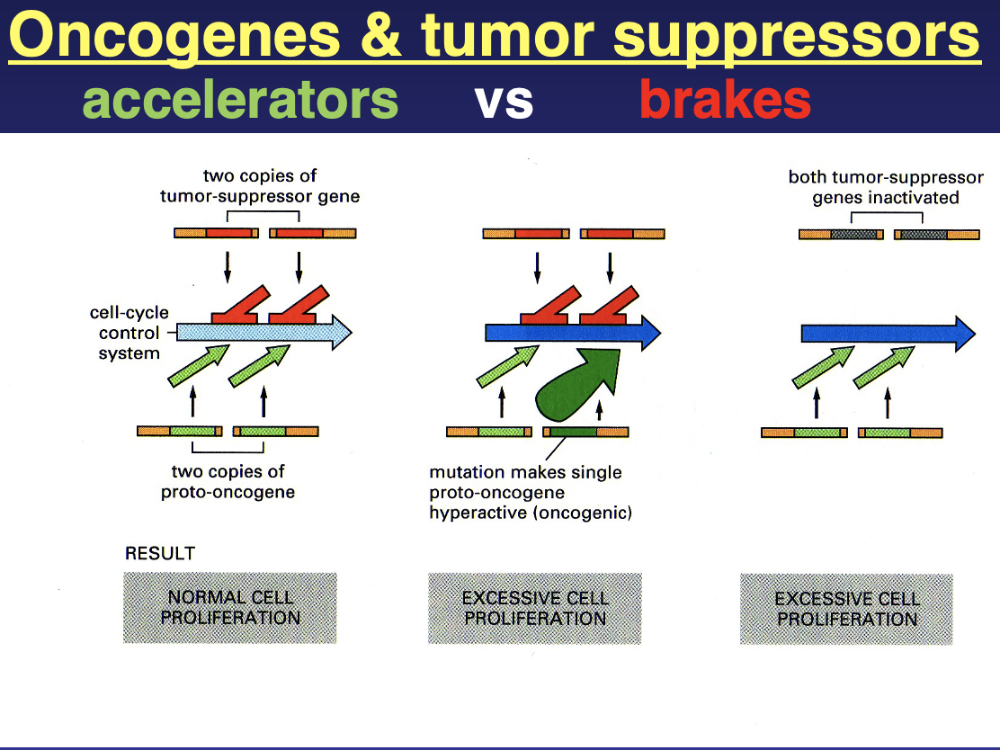
oncogenes - accelerators
- 1 oncogene mutated = enough for excessive cell proliferation
tumor suppressors - brakes
- BOTH tumor suppressor genes inactivated = excessive cell proliferation
viruses associated w/ human cancer
KNOW THESE PROBABLY
- DNA viruses
- HPV -> cervical carcinoma
- Hep B -> liver cancer
- Herpesvirus family:
- epstein barr virus -> burkitt's lymphoma
- HHV8 -> kaposi's sarcoma
- RNA viruses
- Hep C -> liver cancer
- retrovirus family -> adult T cell leukemia